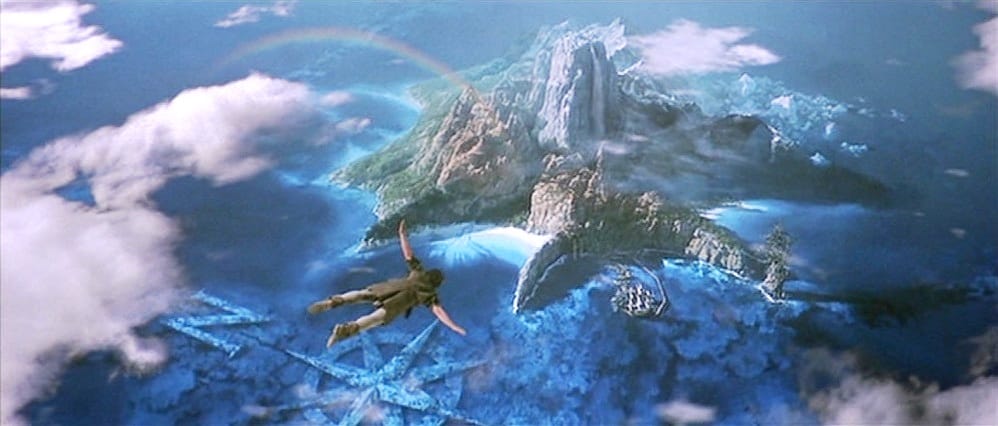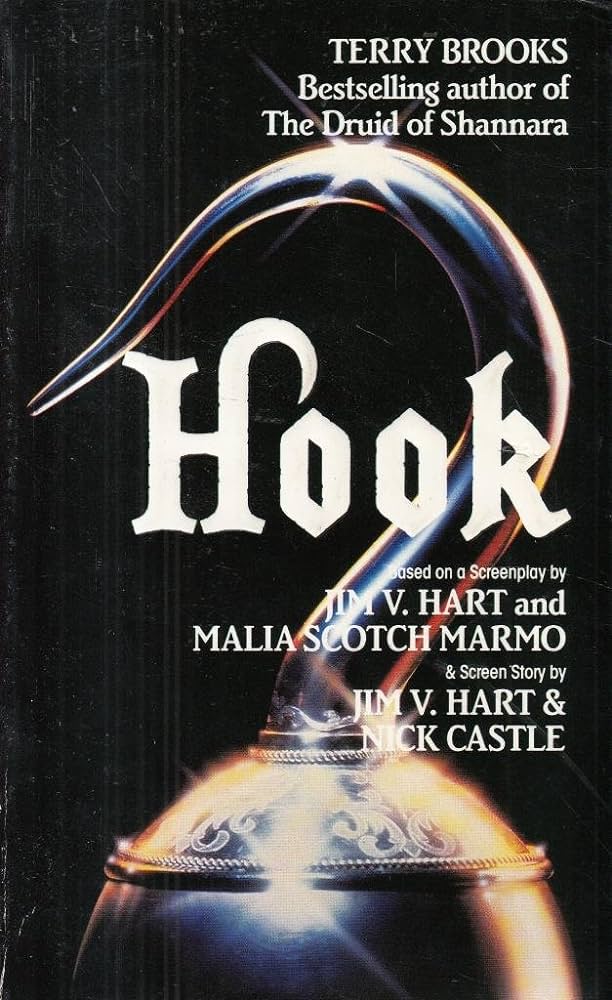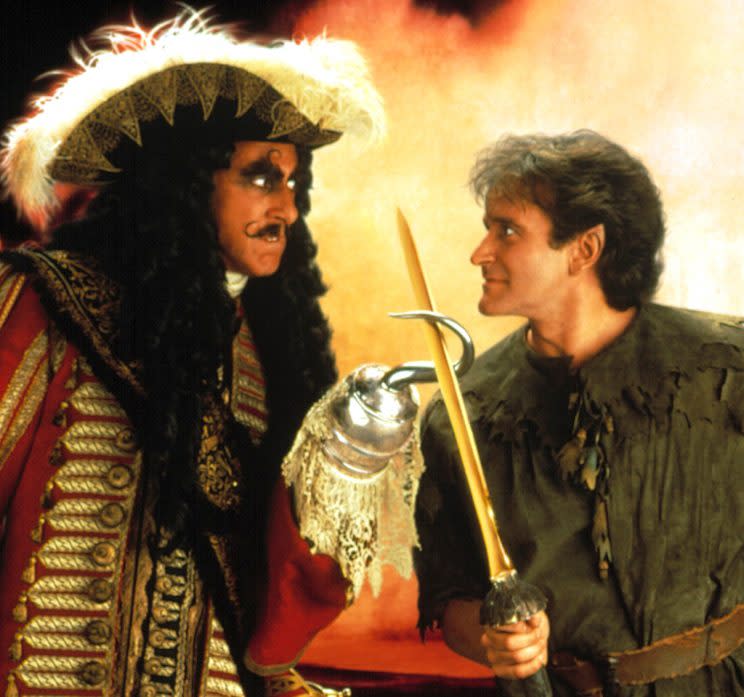Hollywood & Spine Archive: Hooked
An overview of the novelization to Steven Spielberg's HOOK, originally published in March 2019.

Hook was a novelization I enthusiastically read in middle school and absolutely one of the first on my mind when it came time to make this project happen. That "Posner, Nail & Banning" trivia has stuck in my head for years. I remember it better than some passwords. Also, I can't believe I went the whole essay without shouting out one of John Williams' best scores. A sweet expanded edition of the soundtrack was released by La-La Land Records in 2023 after years in development; I was well aware of its gestation by the time I wrote this. (Originally published 3/5/2019)

Hook: A Novel by Terry Brooks (based on a screenplay by Jim V. Hart and Malia Scotch Marmo and screen story by Jim V. Hart & Nick Castle) (Fawcett Columbine Books, 1991)
The pitch: Workaholic lawyer Peter Banning's children are kidnapped on a family trip to London - and to rescue them, he must come to terms with his forgotten past as Peter Pan, the boy who didn't grow up.
The author: Inspired in equal measure by Tolkien and Faulkner, Terry Brooks' Shannara series has sold more than 21 million copies across more than 30 titles. Hook is one of his only non-Shannara fiction books, along with the novelization to Star Wars: The Phantom Menace in 1999.
The lowdown: The best comparison to Steven Spielberg's Hook as prose is the illustrated adaptations of the film I read as a child. The story was intact, but the artwork didn't use the likenesses of either Robin Williams (as wayward yuppie-turned-believer Peter Banning) or Dustin Hoffman (as a depressed, vengeful Hook).
Getting the characters "wrong" in a novelization is a common pitfall. The author neither sees nor hears how the actors embody their roles - they read the script and take their best shots. Assessing that literary conjecture is what makes Hollywood & Spine so much fun; even if it's "wrong" to the reader, it's always interesting. Such is the case with Hook, a modern-day retelling/updating of J.M. Barrie's famed children's story considered at the time to have misfired but certainly seen differently by the sympathetic eyes of the now-grown children who experienced it more than 25 years ago. (While its running time is excessive and some of its performances too pat in places, it's hard to imagine a decade or more of British lit-oriented children's films without its influence, from Matilda to the early adaptations of the Harry Potter series.)

Hook is an oddity in Spielberg's filmography: arguably the last in his imperial blockbuster phase (which I'm quantifying as 1975-1993) to value sentimentality over substance, and also among his last to suffer from production and budget excesses (a common problem early in his career). The script hadn't originated with Steven, either: original director Nick Castle received a story credit with initial writer Jim Hart, and Spielberg hired Malia Scotch Marmo (and an uncredited Carrie Fisher) to punch up Hart's dialogue.
With all this behind-the-scenes intrigue and breakneck scheduling, it's notable that Terry Brooks adapts the world of Hook as ably as he does. The colorful, whimsical sprawl of Neverland, its pirate brigade and Lost Boys hangout, is rendered in vivid verbal detail, down to the three suns and six moons in its sky. Brooks chooses to write some dialogue in accents, which works well in places (Smee, Hook's long-suffering bosun) and badly in others (Lost Boy leader Rufio slips in and out of a patois, fellow Lost Boy Pockets is written as if congested).
If anyone's dialogue suffers most, it's Peter, who lacks the color and spontaneity that Robin Williams brought to the screen. Here, he is more palpably petulant, possessing none of Williams' do-your-best charm. It makes certain passages uncomfortable or irrational, like his early speech in honor of Granny Wendy (in the book, it's improvised after forgetting his notecards, and it's hard to understand how a cold character like this could speak so eloquently) or his futile tears at losing the children he spent most of his time neglecting.

His interactions with the Lost Boys fare worse. Consider a highlight from Peter's verbal sparring match with Rufio while training with the Lost Boys:
PETER
You are a very poor role model for these kids, do you know that?...I bet you don't even have a fourth-grade reading level.
RUFIO
Hemorrhoidal sucknavel!
PETER
...Well, maybe a fifth-grade reading level.
In the book, it's far clunkier:
Peter had had enough. He pointed at Rufio and shook his finger. "You are an extremely poor role model for these children."
The Lost Boys whistled and used their hands to mimic the crashing of airplanes.
"All right!" snapped Peter, not wanting to back off. "You...you are a third-rate person!"
"Hemorrhoidal sucknavel!" Rufio sneered. He looked cocky and self-assured sitting there, his eyes laughing.
"Fourth-rate person!" charged Peter.
Which is nothing compared to Peter's winning blow two pages later: "You tight-brained, three-button, gold-card, alligator-belted crock of shishkabibble-toothed, liberal left-wing corporate lawyer, eating his boogers...like a paramecium suffering from Pan envy!" Yikes. But the jitters are baked into Banning's undesirability as a character; when in Pan mode, Brooks shines, recalling (and even quoting at times) Barrie's original aesthetic of the triumphant hero.
Hook himself doesn't quite get the camp treatment Hoffman lent the character, though his confused rage at seeing his rival Pan grow up is still palpable. With no pictures (the color spread in the middle of the book doesn't count), the text tips its hand toward Hook's secret image - a frail, elderly man whose wig and vestments give him a deceptively sinister air - earlier and more explicitly than it does in the film. (On the page, this reveal occurs during his suicidal "nightcap" with Smee, which has none of the queer subtext Hoffman and Bob Hoskins, as Smee, intended.)

The cutting room floor: The Hook novel presents less "deleted" scenes and more extended ones (not unlike those in the special features of the film's recent 4K home video release). Other extras include more time at Peter's law firm, where a scientific consultant vies for attention regarding to the land deal Banning's trying to close. (A great, useless piece of trivia: the firm is named Posner, Nail & Banning, after Spielberg's mother Leah Posner and wife Kate Capshaw, born Kathleen Sue Nail.) There's also a rapid-fire attempt by Tinkerbell to get Peter to think of a happy thought before he's flung from a slingshot ("the Proctor & Gamble deal," he meekly offers) and an extended day of Hook winning Peter's son Jack over with pirate whimsies.
The verdict: It's slightly drier where the film is perhaps too dewy, but die-hard fans might enjoy this look at Hook.
